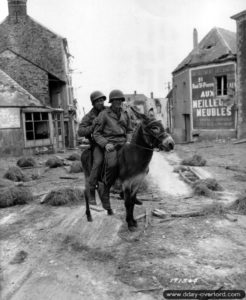Caumont-l’Eventé (Calvados)
The cities of Normandy during the 1944 battles
July 8, 1944: Private William Jackson and Private Joseph King of the U.S. 1st Infantry Division ride donkeys along the road from Caen to Caumont-l’Eventé. Photo: US National Archives
- Librration: 13 june 1944
- Units engaged:
![]() 18th Infantry Regiment, 1st Infantry Division
18th Infantry Regiment, 1st Infantry Division
![]() 26th Infantry Regiment, 1st Infantry Division
26th Infantry Regiment, 1st Infantry Division
![]() 743rd Tank Battalion, 1st Infantry Division
743rd Tank Battalion, 1st Infantry Division
![]() 635th Tank Destroyer Battalion, 1st Infantry Division
635th Tank Destroyer Battalion, 1st Infantry Division
![]() Panzer-Aufklärungs-Abteilung 2, 2. Panzer-Division
Panzer-Aufklärungs-Abteilung 2, 2. Panzer-Division
- History:
The initial planning for Operation Overlord estimated that the village of Caumont-l’Eventé should be under the control of the US 5th Corps nine days after the start of the landings. Despite heavy losses incurred on June 6, 1944, to establish the beachhead in the Omaha Beach sector, the Americans managed to make up some of their lost time. The commune of Caumont, perched on a hilltop offering a wide panorama of the region, particularly the Drôme Valley and the Cerisy Forest, represents an important road junction between Saint-Lô and Villers-Bocage. The village is also located at the edge of the zone dedicated to the US 1st Army, bordering that of the British 2nd Army: these limits of coordination, especially between two different armies, represent a constant concern for the military who must ensure that the enemy does not infiltrate it. To this end, the U.S. 5th Corps established careful coordination with its neighbor, the British 30th Corps, taking care to advance at the same speed.
On the German side, the rapid American advance in this sector created a salient in their position, between the Panzer Lehr Division east of Caumont and the remnants of the 352nd Infantry Division to the west. To prevent this potential breakthrough, the first elements of the 2nd Panzer Division, which were arriving in Normandy in small groups, were immediately committed.
At 5:00 p.m. on June 11, the 5th Corps received its new orders, which designated Caumont and Hill 192 as its new objectives. Seven hours later, the 1st (US) Infantry Division drew up its own directives: supported by six artillery battalions, the unit advanced with the 18th (to the west) and 26th (to the east) front infantry regiments, each reinforced by a squadron of the 635th Tank Destroyer Battalion.
On the evening of June 12, the 2nd Battalion of the 26th Infantry Regiment (IR) reached the outskirts of Caumont-l’Eventé, having encountered only light German resistance along the way. In the early hours of the night, light reconnaissance was ordered to test the defensive position in the village: their report suggested that the town was held by only the equivalent of two companies of the 2nd Panzer Division. The commanding officer of the 26th Infantry Regiment, Colonel John F. R. Seitz, gave the order to capture it during the night. But the Germans held firm and repelled all attempts by the American F Company, supporting their defense with a handful of armored vehicles and an 88mm cannon.
At daybreak, the American tanks of the 743rd Tank Battalion resumed their forward action to dislodge the enemy. They were accompanied by forward observers to deliver rapid and accurate artillery fire. Despite this unfavorable balance of power, the Germans only broke contact after a fierce defense of the village. At 9:00 a.m. on June 13, Caumont-l’Eventé was liberated. The artillerymen immediately observed the new terrain opening up to them from the heights of the village: they took advantage of this to prepare new firing lists.
Aware of the tactical significance of this loss, the Germans attempted to dislodge the Americans from the village and Hill 192: from early afternoon, they multiplied their incursions through the defenses of the 18th and 26th Regiments, which were struggling to secure their positions. At 3 p.m., the intervention of the artillery definitively pushed back the soldiers of Panzer-Aufklärungs-Abteilung 2: 895 shells were fired by the American gunners of the 33rd Field Artillery Battalion to prevent any infiltration.
Map of Caumont-l’Eventé :

